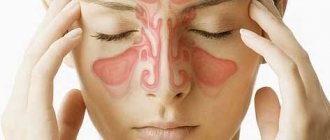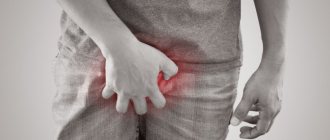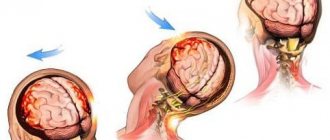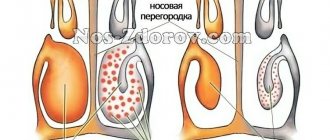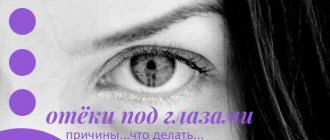Neurogenic dysfunctions occur regularly in patients. The number of sufferers, according to statistical estimates, is more than 30% of the people on the planet.
For the most part, these are relatively mild deviations from the norm, which are not even always noticeable, up to a certain point.
Numbness of the face is one of the possible neurological symptoms of diseases of the musculoskeletal system, processes in the brain, blood vessels of the neck and other structures.
The symptom is diverse and is present in a large number of pathological processes. The cause of the deviation can be identified through instrumental diagnostics.
In some cases, sensory loss indicates an emergency condition, such as a stroke. Therefore, when such a symptom develops, especially if it is combined with paresis or paralysis, an ambulance must be called to exclude necrosis of cerebral structures.
Therapy depends on the case. Numbness itself does not require correction; it is necessary to influence the provoking factor. This is the basis.
Migraine
It is still considered a mysterious disease. Mainly found in women, the ratio of the number of patients m/f can be determined as 3:1 and even more.
It has a clear hereditary nature, if one of the parents had a disorder, with a probability of over 70% the disorder is transmitted to children and manifests itself at some point.
Why migraine develops is not known for certain. It is assumed that the disorder is caused by spasm of cerebral vessels against the background of autonomic dysfunction. That is, we are talking about a purely neurological disease, but whether this is true or not is a moot point.
The symptomatic complex is always approximately the same. In classic cases, the following signs of the condition are found:
- Severe headache. On the one side. Left or right. Baling, shooting, bursting. Accompanies the patient throughout the entire episode of the disorder. It radiates into the orbit and can move towards the crown and back of the head, initially located in the frontal region.
- Nausea, rarely vomiting.
- Disorientation in space. A person cannot move normally, the world is spinning and spinning before his eyes.
- Numbness of the entire head or part of the face as a result of a disorder of nerve conduction at the level of cerebral structures. This is a temporary phenomenon that does not indicate either the severity of the problem or the likelihood of a favorable outcome.
Physiotherapeutic methods for treating facial numbness
Treatment will depend on what exactly caused the illness. If a person is getting ready for bed and finds that his face is numb, it is important to restore blood circulation with a little massage. However, if in addition to this, paralysis of other limbs is observed, you should immediately contact a specialist.
Immediate hospitalization is required for numbness due to back, head or cervical injuries. Uncontrolled bowel movements should also be considered alarming symptoms.
Weakness and prolonged dizziness often accompany facial numbness; this is also an alarming symptom. However, it cannot be said for sure that it is the numbness of the right side of the face or the left that is a symptom of any disease.
If there is a lack of vitamins, the attending physician can prescribe microelements or, in extreme cases, recommend dietary supplements. Despite the fact that the treating doctor will not give direct recommendations of this nature, yoga or meditation can be an effective remedy.
For trigeminal neuralgia, drugs that reduce inflammation are used. In some cases, painkillers are prescribed. The trigeminal nerve exits in front of the auricle and divides into 3 branches. Usually only the lower part becomes inflamed, while the upper part remains unaffected.
Physiotherapeutic methods include the following:
- Acupressure. The method consists of a targeted effect on the affected areas of the face. It is done with the help of fingers, at this time the points are activated, which allows you to relieve numbness. The area of acupressure treatment depends on which part of the face is affected. If the left side of the face is numb, massage is performed only on the left side; if the right side is numb, massage should be performed on the right side.
- Acupuncture. Acupuncture can be called more clearly - acupuncture. It is used to administer certain medications.
- Ultraphonophoresis. Allows you to use ultrasonic waves to get rid of facial numbness by injecting medication into the subcutaneous cells.
These methods allow you to completely get rid of facial numbness if it is not caused by serious diseases. The procedures restore blood circulation and lymphatic drainage in the skin.
If during the examination it was revealed that the patient’s right side of the face is numb, then it is quite possible that the methods listed above will be able to completely eliminate this ailment. However, numbness will not go away if its cause is hidden in a more serious illness.
When the above does not provide any relief, a more serious condition is very likely. At the same time, timely diagnosis is important, because the disease can be started. It is worth noting that to prevent facial numbness, it is recommended to lead a healthy lifestyle. This includes proper nutrition, exercise, and good, sound sleep. For example, if the left side of your face is numb, but the right is not, this may be a consequence of both an unhealthy lifestyle and developing pathologies.
Constant movement reduces the likelihood of facial numbness, paying enough attention to monitoring the musculoskeletal system and tissue blood supply will minimize the risk of numbness. Food must necessarily contain B vitamins and the necessary set of minerals.
In other words, it is important to monitor your lifestyle and, if necessary, immediately seek the help of specialists. In this case, prevention is much easier than dealing with emerging diseases. Facial numbness should be taken extremely seriously as it can lead to various adverse effects. If the right side of your face is constantly numb, you need to change your lifestyle and consult a specialist for advice.
When facial skin is numb, the relationship between causes and treatment should be taken into account. To eliminate decreased sensitivity as a sign of disease, treatment of the primary disease is required. If, after eliminating the cause of numbness, the symptom continues to bother you, or physiotherapy is prescribed as rehabilitation or auxiliary therapy.
The choice of therapy depends on the location of the nervous disorder and general symptoms. In general, regular rehabilitation and active training of facial muscles are important, preferably several times a day. Basically we are talking about performing manual stimulation of the affected muscles, performing manual massage in combination with massaging with foam balls.
We can also stimulate the affected areas using thermotherapy methods. We are talking about heating (using hot compresses) or cooling (using cold/ice compresses).
Using heating or cooling, the patient should be treated using a method that brings him relief. How long facial numbness lasts depends on the correct choice of therapeutic approach. If the sensory impairment is alleviated but not eliminated, then the problem requires a different approach. If necessary, additional examinations are carried out.
The therapeutic technique is determined individually in all situations. Traditional and non-traditional methods of therapy are used. Exercise therapy is carried out for radicular syndromes to improve one’s condition; doctors also recommend massage, reflexology and physiotherapy. Numbness of the body in diabetes is treated by endocrinologists, drugs and diet are prescribed, and lifestyle is adjusted.
Numbness of parts of the body on the right side requires increased physical activity and adjustments to the diet. Nicotine, alcohol, peppery and salty foods have a harmful effect on the condition of the circulatory system and cartilage tissue. You need to dress according to the weather so that hypothermia does not occur; diseases will be treated in time without becoming chronic.
Drug therapy involves the use of:
- Medicines that reduce pain and inflammation.
- Medications that reduce spasms.
- Drugs that aggravate the conduction of nerve impulses.
- Medicines that improve the functioning of the blood supply system.
- Medicines that stabilize blood pressure.
To prevent negative reactions of the body you need:
- Take frequent breaks from work that involves being in the same body position, and do exercises.
- Mattresses and pillows must be of high quality.
- Nutrition needs to be improved to reduce weight and strengthen the diet with vitamins.
- Perform therapeutic exercises that strengthen joints and intervertebral discs, promoting blood circulation.
There is no need to eliminate numbness caused by complex diseases and folk recipes. Such symptoms can be stopped, but the disease will not be cured. As a result, the symptoms will be much brighter and more severe.
Osteochondrosis
It is an inflammatory, degenerative-dystrophic disorder of the spine, in particular, the cervical region suffers.
The pathology develops and progresses gradually and steadily. Detecting the moment when the disorder reaches a dangerous level is not easy.
Neurological symptoms, such as impaired facial sensitivity and others, also do not develop overnight, over many years.
Signs are specific:
- Pain in the neck area. Popping, burning or bursting. Fickle. Intensifies after physical activity.
- Dizziness. Accompanied by the inability to navigate in space. Develops sporadically.
- Cephalgia. Pain in the back of the head, crown.
- Problems with motor activity of the cervical spine. It is impossible to turn, motor abilities decrease gradually but steadily.
- Numbness of the face, lips, tongue and head with osteochondrosis is common, along with a decrease in sensitivity in the hands. This is a late sign. In the initial phase, it is present when the nerve endings are pinched, then, when the roots die, it remains permanently.
- Nausea. Vomiting is less common.
- Problems with cardiac activity. Like tachycardia. Relatively rare.
Disruption of the musculoskeletal system provokes characteristic manifestations due to compression of nerve endings at the local level.
It is necessary to differentiate from hernias of the cervical spine. As a rule, both processes occur in parallel.
Recipes for home remedies for facial tightness
You can take care of dry skin not only with the help of store-bought products with chemical components, but also with homemade, self-prepared masks and creams. So, what to do if your facial skin feels tight and very dry? Use the following recipes:
- Avocado based mask . Using a blender, mix a mixture of 1 grated banana and avocado. Apply the mask to your face and leave for 15-20 minutes. Rinse with water at room temperature.
- Yolk mask. Take 1 yolk, 1 tsp. milk powder and 1 tsp. natural honey. Apply the mixture to dry areas on the face and leave for 20 minutes. Then wash off with warm water.
- Recipe based on lemon and sour cream . Mix 1 tsp. homemade sour cream with ¼ tsp. turmeric, add a couple of drops of fresh lemon juice. Apply the mixture for 15 minutes. After this, massage your face for another five minutes and wash off the mask with room water.
- Almond mask . Soak a couple of almonds overnight. Peel them and grind them to form a paste. Add a few teaspoons of milk, 1 spoon of flour and fresh lemon juice. Apply the mask and leave to act for 20 minutes. This recipe helps not only with tightness, but also to restore the elasticity of the facial skin.
- Cottage cheese mask . Apply crushed cottage cheese, after adding honey and fresh lemon juice. Keep it on your face for 10 minutes, then wash it off.
- Aloe Vera Recipe. Generously lubricate the dry areas with plant juice and wait half an hour. This is an excellent moisturizer that helps form a layer of protection on the face, making the skin softer and more elastic. Aloe is a plant whose juice eliminates dead skin cells and prevents age-related changes.
- Cucumber mask . This is a whitening and moisturizing product. Mash one cucumber to a porridge state and apply on the face. We wait half an hour, then rinse with warm water. Repeating the procedure daily for one week will give a stunning effect.
- Rose water recipe. Mix 1 tsp. rose water with the same amount of natural honey. Apply to dry areas. This recipe helps cleanse the skin, tone it and make it glowing.
- Banana mask . This is one of the most beneficial products for dry skin. Mash one fruit and apply the paste to the face as a mask. Leave for half an hour, then wash off. This way you will eliminate irritation and make your face softer and more tender.
- Remedy made from olive oil and yolk . Mix the yolk with 1 tsp. quality olive oil, add a little fresh lemon juice and rose oil. Apply the mask to your face and keep it on for 15 minutes. Rinse with warm water.
Effective tips on what to do if your facial skin is very dry are offered in the video:
Hernias of the cervical spine
A dangerous complication of osteochondrosis. Less commonly it develops as a result of injury or sudden movement. For example, after a car accident, an unfortunate fall, a fracture, etc.
The essence of the disorder is the displacement of the intervertebral disc beyond its normal anatomical position. Then it breaks and completely loses its own structure and function.
This leads to abrasion and degeneration of adjacent vertebrae and even greater limitation of activity and severe discomfort.
The clinical picture is typical. Disorders of the musculoskeletal system are accompanied by severe, sometimes unbearable pain in the neck (in an acute state they do not go away at all), problems with orientation in space.
The patient cannot hold his head up because the muscle corset is weak.
In almost 100% of cases, a clinical picture of vertebrobasilar insufficiency is detected; due to instability of the spinal column, compression of local arteries occurs.
The therapy is surgical, but doctors are delaying the moment as best they can. They stop attacks and prevent new ones.
Limbs
Numbness on the left side of the body occurs most often in middle-aged people. At the same time, a burning sensation or coldness is felt. Causes may be congenital or acquired. Problems with sensitivity indicate the appearance of disorders of the nervous system, heart and blood vessels.
Paresthesia appears in the following conditions:
- Heart attack.
- Ischemic disorders.
- Osteochondrosis.
- Brain hemorrhage.
- Problems with blood vessels in the head.
The ischemic disorder causes persistent numbness in the left limb. At the same time, pain in the sternum and heart is detected. The sensitivity of the left hand and forearm worsens. After a heart attack, my arms and left leg go numb. Trying to eliminate the symptoms on your own is undesirable; you need to seek help from a doctor.
You'll have to call an ambulance or go to the hospital. In case of such problems, a comprehensive examination by cardiologists and other specialists is carried out. With the help of modern equipment, the reason why the body goes numb is determined.
After this, the doctor prescribes treatment, which involves taking medications and following general recommendations:
- Quitting alcohol and smoking.
- Strong coffee is eliminated from the diet.
- Hot food and cereals are included in the diet.
- It is recommended to play sports, run, exercise in the pool, skiing.
Prevention stabilizes the blood supply system, ensuring uninterrupted blood flow to the arms and legs.
Vertebrobasilar insufficiency
A common disorder. Usually develops as a complication of osteochondrosis of the cervical spine.
The essence of the disease is a sharp disruption in the nutrition of cerebral structures due to compression of the arteries localized in the neck.
There are many variants of the clinical picture of the disease. Basically, the symptomatic complex comes down to a group of deviations:
- Headache. Expressed, strong. Migraine attacks are possible during the course of the disease.
- Dizziness and inability to navigate in space. The person is in a forced position. Lying on his side, he moves little.
- Nausea, vomiting.
- Visual impairment. Loss of areas of visibility, sensation of bright flashes (simple hallucinations), temporary total blindness is possible. In late, advanced stages.
- Decreased hearing acuity.
- Inability to move smoothly. Unsteadiness of gait. This is all due to disruption of the extrapyramidal system.
- When the lobes of the brain on the left side are affected, the right side of the head (and the body in general) goes numb and vice versa.
Also other clinical signs. VBI is considered a significant factor in the development of stroke in the future. The cerebellum and occipital region of the brain are affected.
With timely treatment, it is possible to stop the progression of the disease and take control of the situation.
Face and head
Patients often worry about numbness in the head and facial muscles. Such symptoms are rarely caused by the body’s natural response to external factors.
A temporary decrease in sensitivity in the face or back of the head occurs in the following situations:
- After sleep, when the head was in an unnatural position.
- Reading, working on a computer and many other activities require holding your head statically in one position.
- The effects of panic attacks, neuroses.
Pathological conditions include stroke, which is expressed by numbness, while the skin rarely becomes numb on the right.
Numbness of the face may indicate the following situations:
- Trigeminal neuritis.
- Migraine.
- Neurosis.
- VSD.
- Slerosis.
- Damage to nerve fibers.
- Cerebrovascular disorders.
Deterioration in the sensitivity of the tongue, chin, and cheeks can be caused by dental disorders and jaw injuries. If there are disorders in the cervical spine during the occurrence of VSD attacks or pressure changes, the head and skin in some places may become numb.
Disorders of the tongue, pharynx, and oral mucosa occur with the following disorders:
- Glossalgia.
- Hot food burns.
- Candidiasis.
- Spasm of nerve tissue.
Numbness of varying degrees of localization appears due to nervous overstrain and stressful situations. Insect bites can cause sensitivity problems.
Cluster headaches
An extremely rare neurological condition. However, it is very difficult. Accompanied by unbearable, painful attacks of discomfort in the frontal region.
Unpleasant sensations radiate to the eyes. The clinical picture is complemented by pronounced numbness on the left side of the face or vice versa, depending on the exact localization of vascular spasm.
The etiology of the disease is unknown. It is believed to be a related condition to migraine, with some differences.
A typical symptom is a severe headache that cannot be relieved by any medications. The intensity of the discomfort is so great that suicide attempts are known among patients during an attack.
Treatment is not possible; the only thing doctors seek is to prevent relapses in the future. Reducing the risks of developing such.
Symptoms and manifestations
Inflammation of the trigeminal nerve is accompanied by redness and heat of the face on one side
Numbness in the upper body is accompanied by other unpleasant sensations:
- tingling, crawling sensations, pain in various parts of the neck, head, face;
- swelling, burning sensation, dysfunction of the facial muscles up to paralysis;
- temperature increase;
- blurred vision, tinnitus, objects appearing double;
- weakness, weakness, weak limbs;
- hair loss;
- dizzy, stuffy ears;
- memory impairment;
- Because of weakness I want to lie down all the time.
The cause of numbness in the head may be the onset of a stroke. Discomfort occurs in the occipital region. Additionally, vision and coordination deteriorate, and the person cannot speak clearly.
With neuritis, the pain is sharp, burning, covering the head and face. The right or left side of the head and the skin in the area of the affected nerve become numb.
Multiple sclerosis is accompanied by loss of sensitivity, tremors, and loss of coordination. There are problems with memory, swallowing, and urination. The sense of touch becomes aggravated, and depressive states develop.
If you have problems with cerebral circulation, you are worried about constant severe headache, dizziness, vomiting and nausea, and stuffy ears. The limbs, head and neck become numb, convulsions, insomnia, and apathy occur.
Bell's palsy is an inflammation of the facial nerve, accompanied by a sudden and rapid development. First, there is pain behind the ear, then taste perception disappears. After 2-3 days, the left or right side of the head and tongue go numb, and unilateral paralysis of the facial muscles develops.
Autonomic dysfunction causes frequent headaches and migraines, attacks of dizziness, and increased sweating. Nervous disorders are accompanied by tachycardia, arrhythmia, weakness, and drowsiness.
Rash and numbness during exacerbation of herpes on the face
When shingles develops, the numb area turns red, tingles, and a rash appears, as with chickenpox or herpes. Additional symptoms are painful shooting in the affected area, weakness, fever.
With cluster headaches, the attacks are unbearable and painful. Unbearable pain in the frontal and temporal region radiates to the eyes, the left side of the face goes numb. The pain syndrome is not relieved even by strong painkillers.
Infectious pathologies of the brain are accompanied by a sharp increase in temperature to 39 degrees or more. I am worried about attacks of nausea, vomiting, the neck muscles are tense, the scalp and face are numb. Other neurological disorders are observed - problems with speech, memory, vision, confusion.
Neurological symptoms in the form of numbness and dizziness with osteochondrosis appear in the later stages of the disease. The pathology is accompanied by throbbing, bursting pain in the neck, which intensifies after physical exertion or prolonged lying down.
With vitamin deficiency, hair falls out, the condition of the skin and hair worsens, and chronic fatigue develops. With a lack of B vitamins, the functioning of the nervous system is disrupted.
Transient ischemic attack
A common phenomenon. It is mistakenly called a microstroke. In fact, we are talking about an acute but temporary disruption of brain nutrition. Develops as a precursor to an emergency condition.
The main patient population is people with a history of arterial hypertension, often elderly.
The clinical picture is identical to that of a typical stroke. The only difference is the duration of the violation and its outcome.
Transient ischemia does not lead to necrosis of nerve tissue; moreover, it regresses spontaneously, independently, even without the help of a specialist. If I may say so, this is a rehearsal for a stroke.
Among the manifestations:
- Severe headache in one area or another. Bursting, baling. Intense.
- Disorientation in space.
- Nausea, vomiting.
- Discomfortable sensations on the skin: goosebumps, tingling. A typical patient complaint is that half of the face or arm is numb. This is an indication of a disruption in the conductivity of nerve endings, but not the death of them.
- Confusion.
- Dysfunctions of the sense organs.
If your head goes numb, it could be a transient ischemic attack or a chronic brain disorder.
Differential diagnosis is mandatory. It is aimed at distinguishing between different conditions.
The main causes of facial skin tightness
The very first thing you need to do to get rid of the problem is to determine its cause. As we have already found out, in a broad sense there are only two of them: improper care and dehydration. Now let's look at them in a more private manner.
Here are some mistakes in care and deviations in the body that most often lead to tightness:
- Negative impact of the external environment
. If you work in hazardous conditions, such as a construction site, constant exposure to dust and other negative elements can change cellular structure and lead to local dehydration. Prolonged exposure to frost, wind, heat and other unfavorable factors has approximately the same effect on sensitive facial skin. An indicator that you do not perceive a particular weather condition well is a strong feeling of tightness and dryness of the skin when returning home or when moving to another place with a more comfortable microclimate. - Lack of nutrients
. If your body's vitamin and mineral balance is disturbed or you don't stay hydrated, it will most likely affect your skin. In this case, however, the consequences are unpredictable. A lack of nutrients can lead to both increased oiliness and rashes, and excessive dryness and tightness. - Incorrect care
. This means either incorrect skin care products or poor hygiene in general. It is necessary to cleanse the epidermis twice a day - morning and evening, it is advisable to use special soft products for this. If you wash your face with regular soap, don’t be surprised by the feeling of tightness. By the way, very often owners of oily skin use too much alcohol-based cosmetics in the fight against inflammation, as a result of which they cause another problem - peeling and tightness. - Poor nutrition
. Today, supermarkets are full of refined foods, loaded with preservatives and other not-so-healthy ingredients. Of course, you can occasionally allow yourself harmful goodies, but if you sin with an abundance of such food in your diet, this immediately negatively affects the intestines, the indicator of which is the skin. - Hormonal imbalance
. Just like a lack of nutrients, hormone imbalance can cause a variety of problems with the dermis - from excess oiliness and acne to flaking and tightness.
In addition, it is worth noting that skin tightness may indicate other internal disorders and pathological conditions of the body.
Stroke
Acute cerebrovascular accident. According to statistics, it is somewhat less common than a heart attack and is the second most important factor in deaths around the world.
The essence of the disorder is necrosis of cerebral structures. Nerve fibers die and irreversible changes occur in the brain.
The condition is extremely unfavorable in terms of its course; without medical care it leads to death.
Infectious and inflammatory diseases of the brain
Among these, two can be named: meningitis and encephalitis. Both develop against the background of a previous disease (the focus does not matter), or after bites from vectors (for example, ticks).
They occur acutely and are accompanied by pronounced deficit neurological phenomena.
It is not always possible to determine the nature of the disorder even through MRI.
The only reliable diagnostic criterion is the presence of an infectious agent, possibly blood, in the cerebrospinal fluid.
Doctors obtain a sample through puncture. However, this is a dangerous procedure; it is used relatively rarely and only when necessary.
The clinical picture resembles that of a stroke, but the symptomatic complex develops less rapidly.
If help is not given in a timely manner, the disorders persist for a long period and cannot be corrected. Diseases can result in profound disability.
Multiple sclerosis
Common neurological disease. It is of autoimmune and metabolic origin.
Accompanied by destruction of the myelin sheath of nerve fibers. For this reason, the speed of impulse transmission drops, and then the possibility of this is lost completely. The disease affects the brain, less often the spinal cord.
Such degeneration progresses constantly, but does not lead to critical disorders at one point. This is a rather lengthy process. It takes more than one year before disability, often much longer.
Timely treatment can reduce symptoms and significantly slow down the pathological process.
The clinical picture is varied and depends on the location of the area of nerve fiber destruction. Typically, motor dysfunctions, a feeling of numbness of the face and limbs, decreased visual acuity, and cognitive disorders are detected.
Intelligence, however, suffers only slightly, at least in the early stages. Without treatment, there is a high chance of rapid disability.
Inflammation of nerve fibers
Against the background of hypothermia or other infectious diseases. It occurs in one form or another in almost 40% of people; at least once in their life, every second person has encountered a similar problem.
It develops spontaneously and is accompanied by unbearable pain, especially if the trigeminal nerve is affected.
The use of analgesics and anti-inflammatory drugs gives minimal effect. Medical attention and combinations of drugs to relieve discomfort are required.
Numbness and severe pain are the main symptoms. As an addition - an increase in body temperature.
How to contact whom and what needs to be examined
Diagnostics is carried out by neurologists. In some cases, the help of several doctors is required, depending on the situation.
The research is almost always the same:
- Oral questioning of a person to clarify symptoms.
- Anamnesis collection. To better understand the likely origin of the disease.
- Measurement of blood pressure and heart rate.
- Assessment of basic reflexes.
- X-ray of the cervical spine.
- Dopplerography of blood vessels to exclude VBI and impaired cerebral trophism, duplex scanning. Shows the quality and speed of blood flow.
- MRI of the same area. For the diagnosis of hernias, advanced osteochondrosis.
- Tomography of cerebral structures. Perhaps the reason is multiple sclerosis or tumors. In both cases, contrast enhancement with gadolinium is required. This will increase the information content several times.
- General blood test, biochemical.
If necessary, a lumbar puncture is performed to obtain a sample of cerebrospinal fluid. Basically this is enough.
As needed, doctors prescribe additional diagnostic measures.
Treatment
Therapy depends on the disease. Conservative methods are mainly practiced. Medicines from several pharmaceutical groups are used.
- Anti-inflammatory drugs of non-steroidal and hormonal origin. The first ones are Nimesulide, Diclofenac and others. The second is Prednisolone and more powerful analogues. They pursue identical goals and are used according to indications.
- Chondroprotectors. To protect the vertebrae. Structum as an option.
- Cerebrovascular, nootropics. Normalizes brain nutrition. Actovegin, Piracetam, Glycine.
More can be said knowing the specific situation.
Surgery is a last resort. It is practiced for tumors, advanced hernias and in some other cases. When there is no other way out.
What needs to be treated is not numbness, this is impossible and makes no sense, but the underlying pathological process.


